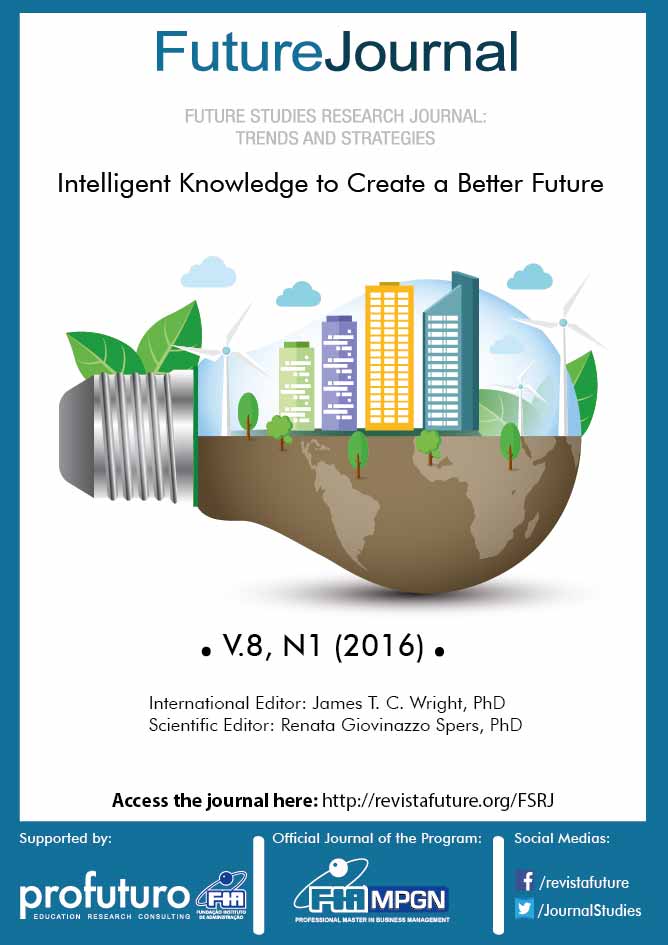Resumo
Neste artigo apresenta-se um caso de uso do Design Thinking em uma disciplina de curso de graduação. O Design Thinking, que visa proporcionar uma inovação na forma de pensar, é composto por um ciclo de etapas que compreendem inspiração, ideação e implementação. Atualmente o termo inovação tem-se mostrado em ascensão em conjunto com o grande número de startups e a intensa procura das empresas para adaptar-se às novas tecnologias e criar diferenciais competitivos no meio em que atuam. Como experimento, foi utilizado o Design Thinking na disciplina de Criatividade e Inovação, na graduação de Sistemas de Informação, sendo executados os passos de imersão, projeto, protótipo e validação, com o objetivo de gerar ideias de serviços inexistentes ou deficitários no campus da faculdade e que poderiam ser oferecidos por terceiros. Após a descrição das etapas do experimento, são apresentados alguns resultados qualitativos e quantitativos e previsões para trabalhos futuros.
Referências
Bloomberg, Business Week Technology. 2013 (September, 20).Apple Chiefs Discuss Strategy, Market Share—and the New iPhones. Recuperado em 19 de julho, 2015, de http://www.businessweek.com/printer/articles/153204-apple-chiefs-discuss-strategy-market-share-and-the-new-iphones
Bonini, L. A., & Endo, G. de B. 2010. Design Thinking: uma nova abordagem para inovação. Recuperado em 23 de maio, 2015, de 2010. http://biblioteca.terraforum.com.br/BibliotecaArtigo/artigo-designthinking.pdf
Boston Consulting Group. 2006. Innovation 2006. Recuperado em 03 de julho, 2015, de http://www.bcg.com/documents/file14826.pdf
Brown, T. 2009. Change by design: how design thinking transforms organizations and inspires innovation. New York: HarperCollins. Recuperado em 03 de julho, 2015, de http://www.ecologyofdesigninhumansystems.com/wp-content/uploads/2012/09/Change-By-Design-Tim-Brown.pdf
Brown, T. 2010. Design thinking: uma metodologia poderosa para decretar o fim das velhas ideias. Rio de Janeiro: Elsevier.
Brown, T. 2008 – Design Thinking. Harvard Business Review, June 2008 Issue, p.84-87.
Franzato, C. 2011. O processo de inovação dirigida pelo design: um modelo teórico. Redige, 2(1), 50-62. Recuperado em 20 de julho, 2015, de http://www.cetiqt.senai.br/ead/redige/index.php/redige/article/download/72/138&ei=gc8xuu6jioa29gtq8yhgcw&usg=afqjcngdv6s4jou5ld2tranzamyi8rfwow&bvm=bv.52109249,d.ewu
Martin, R. L. 2009. The design of business: why Design Thinking is the next competitive advantage. Boston: Harvard Business Press.
Nakagawa, M. 2014. Ferramenta: Design Thinking para empreendedores. Recuperado em 23 de maio, 2015, de http://cms-empreenda.s3.amazonaws.com/empreenda/files_static/arquivos/2014/04/07/Design_Thinking_.pdf
Pinheiro, T., Alt, L., & Pontes, F. 2012. Design Thinking Brasil: empatia, colaboração, e experimentação para pessoas, negócios e sociedade. São Paulo: Elsevier.
Vianna, M., Vianna, Y., Adler, I. K., Lucena, B., & Russo, B. 2012. Design thinking: inovação em negócios. Rio de Janeiro: MJV Press. Recuperado em 03 de julho, 2015, de http://www.sebraedesign.com/wp-content/uploads/2013/05/Design-Thinking-Inova%C3%A7%C3%A3o-em-Neg%C3%B3cios.pdf
Authors who publish with this journal agree to the following terms:
1. Authors who publish in this journal agree to the following terms: the author(s) authorize(s) the publication of the text in the journal;
2. The author(s) ensure(s) that the contribution is original and unpublished and that it is not in the process of evaluation by another journal;
3. The journal is not responsible for the views, ideas and concepts presented in articles, and these are the sole responsibility of the author(s);
4. The publishers reserve the right to make textual adjustments and adapt texts to meet with publication standards.
5. Authors retain copyright and grant the journal the right to first publication, with the work simultaneously licensed under the Atribuição NãoComercial SemDerivações 4.0 Internacional, which allows the work to be shared with recognized authorship and initial publication in this journal.
6. Authors are allowed to assume additional contracts separately, for non-exclusive distribution of the version of the work published in this journal (e.g. publish in institutional repository or as a book chapter), with recognition of authorship and initial publication in this journal.
7. Authors are allowed and are encouraged to publish and distribute their work online (e.g. in institutional repositories or on a personal web page) at any point before or during the editorial process, as this can generate positive effects, as well as increase the impact and citations of the published work (see the effect of Free Access) at http://opcit.eprints.org/oacitation-biblio.html
• 8. Authors are able to use ORCID is a system of identification for authors. An ORCID identifier is unique to an individual and acts as a persistent digital identifier to ensure that authors (particularly those with relatively common names) can be distinguished and their work properly attributed.
• 9 The authors commit to serving as reviewers for the journal: As a form of reciprocity with the academic community, Future Studies reinforces the commitment that authors of accepted articles have to act as reviewers for manuscripts submitted to the journal.
Os artigos publicados estão licenciados sob uma licença Creative Commons Atribuição - Não comercial - Sem derivações 4.0 Internacional.



